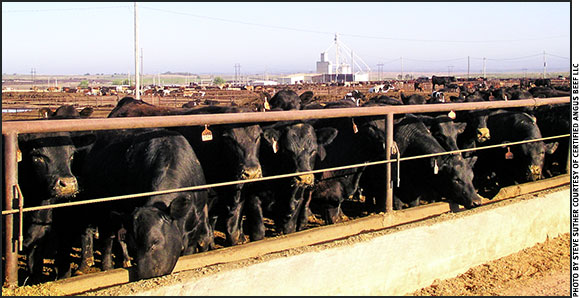
Optimizing the Feeding Value of Corn
Steam-flaking offers increased starch availability resulting in greater digestibility and a predictable increase in performance.
 Figuring out how to feed cattle more efficiently is one of the things ruminant nutrition researchers do. At the University of California–Davis, researcher Richard Zinn has sought ways to glean more nutrient value from feedgrain. Zinn shared information from his research with cattle producers attending the 2017 Cattle Industry Convention in Nashville, Tenn. In an NCBA Trade Show Learning Lounge presentation, he explained how the steam-flaking process affects the feed value of corn.
Figuring out how to feed cattle more efficiently is one of the things ruminant nutrition researchers do. At the University of California–Davis, researcher Richard Zinn has sought ways to glean more nutrient value from feedgrain. Zinn shared information from his research with cattle producers attending the 2017 Cattle Industry Convention in Nashville, Tenn. In an NCBA Trade Show Learning Lounge presentation, he explained how the steam-flaking process affects the feed value of corn.
Zinn acknowledged that dry-rolled corn and high-moisture corn are viable alternatives for use in beef cattle rations. However, research shows that steam-flaking increases the energy value of corn. Many nutritionists consider the energy value of steam-flaked corn to be more than 10% greater when compared to dry-rolled corn and nearly 7% greater compared to high-moisture corn.
“With steam-flaking we get an increase in net energy due to increased starch availability,” explained Zinn, adding that along with improved starch digestion, steam-flaking similarly increases the digestibility of non-starch organic matter.
Zinn noted how steaming causes corn starch particles to swell, and the application of shear (pressing into flakes) breaks the protein matrix that encapsulates unprocessed corn starch particles. The practical result is that starch particles become more “reactive” to enzymes within an animal’s digestive tract, and particularly within the small intestine.
“Steam-flaking results in more complete digestion of starch, but the difference is the result of increased digestion occurring in the small intestine,” said Zinn. “Also, there is an increase in intestinal protein digestion.”
Zinn’s research suggests that, compared to dry-rolled corn, steam-flaked corn delivers a 49% increase in post-ruminal digestion of starch, on average, and a 13% increase in post-ruminal digestion of protein.
Quality considerations for steam-flaked corn include flake thickness and density. According to Zinn, optimal flake thickness ranges from 1.6 to 1.8 millimeters. Optimal density, as measured by bushel weight, is 24 to 28 pounds per bushel. However, Zinn said fecal starch content is a more reliable indicator of flake quality. Measures of 3% or less fecal starch indicate optimal starch digestion.
In closing, Zinn said properly steam-flaked corn offers a predictable increase in animal performance — about 6% improvement to average daily gain, with approximately 4% decrease in dry-matter intake.

Editor’s Note: Field Editor Troy Smith is a freelance writer and cattleman from Sargent, Neb. This article was written as part of Angus Media’s coverage of the 2017 Cattle Industry Convention. For further coverage, read the Angus Journal or visit www.angus.media.






